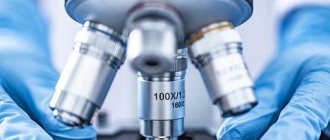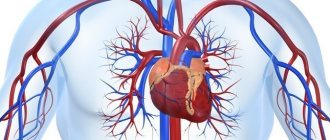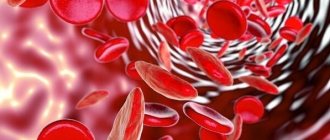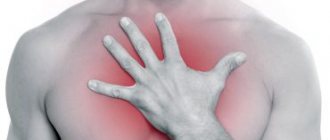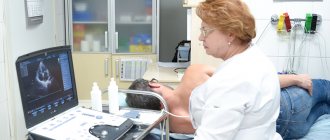Cardiology is a medical science that deals with the prevention, detection, treatment of heart diseases and the circulatory system as a whole. A cardiologist is a doctor who specializes in this area and also works to restore heart function that is impaired due to diseases of other internal organs. The specialist’s task is to promptly detect and eliminate risk factors for cardiovascular pathologies, prevent their occurrence, select the necessary treatment and monitor the condition of patients who have had a heart attack or cardiac surgery.
The history of cardiology goes back hundreds of years. Hippocrates also described the heart as a muscular organ with ventricles and large vessels. And Leonardo da Vinci created many illustrations in which heart valves were clearly visible. If at the beginning of the 19th century doctors were looking for ways to study cardiac and vascular pathologies, now cardiology is aimed at their safe treatment and prevention.
In what cases should you urgently contact a cardiologist?
The insidiousness of many heart and blood vessel diseases lies in their asymptomatic onset. Feeling constant fatigue, often suffering from sore throats, and periodically experiencing mild suffocation, people attribute the malaise to stress, lack of sleep, and intoxication. However, later the symptoms become more pronounced, interfering with everyday life and adjusting plans. You should immediately make an appointment with a cardiologist if you complain of:
- tingling in the heart area;
- aching pain syndrome, a feeling of heaviness on the left side of the chest;
- discomfort in the area of the left shoulder blade and upper limb;
- unstable heartbeat;
- acute pain syndrome behind the sternum;
- shortness of breath when walking and other physical activity;
- pulse less than 50 or more than 90 beats per minute;
- swelling of the lower extremities;
- numbness of part of the face, arms or legs, pain in the calves when walking;
- attacks of throbbing headaches;
- imbalance;
- changes in blood pressure;
- periodic dizziness.
There is no need to self-medicate or mindlessly take medications recommended by a neighbor or relative. It is important to quickly identify the problem and prevent it from taking root in the body.
Risk group: who needs cardiologist supervision
Preventative visits to a cardiologist are necessary even for young people under 35 years of age who do not have health problems. To control the situation, one visit every 2 years is enough. Men and women over 40 years of age should come for a consultation with a specialist once a year. From this age, the course of some chronic diseases worsens, heart ailments appear, and the risk of stroke or heart attack increases significantly.
The cardiac risk group includes people suffering from:
- diabetes mellitus;
- obesity;
- renal failure;
- pulmonary diseases.
Every six months, people whose close relatives have suffered from severe heart and vascular diseases, who have suffered a hypertensive crisis, myocardial infarction, stroke and other acute conditions should come for examination and diagnosis.
Please note! If you smoke, drink alcohol frequently, eat poorly, exercise little, or become very fat, be sure to make an appointment with a cardiologist for prevention, as you are at risk.
Preventive medicine
Because many heart problems are chronic, long-term conditions, a cardiologist focuses on preventive medicine to neutralize and stop any progression of heart disease. Cardiologists perform a physical examination and interview a patient to assess their current health and predict any potential problems. In addition to prescribing medications, a cardiologist can also provide recommendations on proper diet, exercise, and lifestyle to improve heart health and proper functioning.
How is the initial appointment and diagnosis carried out?
No special preparation is required to see a cardiologist. It is enough to take with you your medical history and examination results for the last six months. The scope of the initial consultation includes:
- Anamnesis collection . The specialist finds out what symptoms bother the patient, when they occur (for example, after physical activity, at night), whether there have been problems with the cardiovascular system in the past, whether there are bad habits, allergic reactions.
- Examination of the patient . The doctor examines the skin, mucous membranes of the mouth and eyes, which makes it possible to identify possible circulatory disorders (for example, blueness of the lips, tip of the nose), and the chest area (visible deformation occurs in heart pathologies).
- Palpation . Tissues in the heart area are palpated, and the intensity and amplitude of contractions of the heart muscle are determined.
- Percussion . The organs located in the chest area (lungs, heart, large blood vessels) are tapped and their sizes are determined.
- Auscultation . The sounds of the heart and blood vessels and heart rate are listened to using a phonendoscope.
To obtain a complete clinical picture, an ECG (electrocardiography) is performed. 3 pairs of electrodes are placed on the skin in the heart area and 2 more pairs on the forearms and ankles. The device then records the electrical activity of the heart and displays it in the form of an electrocardiogram.
Important! When going to the cardiologist, wear comfortable underwear so that the doctor can diagnose and you do not feel discomfort.
Myocardial infarction
This is a disease that develops due to blockage of blood vessels in the heart. Due to metabolic disorders in the myocardium, cell death occurs and certain areas of the heart muscle are “switched off” and do not contract, which means the heart does not work at full strength. Over time, this leads to disruption of the nutrition of tissues of various organs - liver, kidneys, brain. A person develops symptoms of heart failure - swelling in the legs, shortness of breath, pain in the right hypochondrium, enlarged liver, cough. Over the years, the contractility of the heart decreases, the heart “spreads” and does not work at full strength, by half, a third or even a quarter.
Treatment methods and follow-up
Depending on the identified disease, the doctor applies a specific treatment regimen:
- a diet with a limited menu of fats, simple carbohydrates, and salt;
- moderate physical activity (race walking, swimming, breathing exercises, etc.);
- morning walks in the fresh air;
- compliance with the work and rest schedule (sleep at least 8 hours);
- rejection of bad habits;
- taking medications;
- physiotherapy.
A set of exercises must be developed (each disease has its own exercise plan), which strengthens the heart muscle, increases blood flow and lowers cholesterol levels.
Dynamic monitoring of patients is required for chronic pathologies: coronary artery disease, hypertension, heart rhythm disturbances, heart failure, etc. The frequency of examinations depends on the nature of the lesions. If a patient has suffered a myocardial infarction or heart surgery, he should visit a cardiologist 2-4 times a month for the first 6 months. If the condition is stable, 2-4 consultations per year are sufficient.
At each regular visit, a standard examination is performed with heart sounds, palpation, blood pressure measurement, and a comprehensive examination is prescribed to assess the course of the disease over time. An ECG and a general blood and urine test are required. Based on the results of the examination, the cardiologist adjusts the treatment regimen and sets a date for the next appearance.
What is a heart?
The heart is a special organ that, like a pump, continuously contracts and relaxes and “drives” blood through the blood vessels.
The heart is divided into four chambers. The two chambers of the heart on the right side receive blood, which has “traveled” throughout the body and is dark red in color. The heart sends this blood through large vessels - the arteries - to the lungs, where it receives a new portion of oxygen and turns bright red. From the lungs, blood returns to the left side of the heart. This is the pulmonary circulation. From the left chambers of the heart, blood enters the large vessel the aorta, and from there to other arteries. Blood delivers oxygen and vitamins to all organs and tissues. Then it returns through the veins to the right half of the heart. This is a large circle of blood circulation. Blood vessels - the vessels through which oxygenated blood flows from the heart to the organs are called arteries; in their walls there are tiny muscles that, by contracting, drive the blood through. The arteries branch and turn into tiny vessels called capillaries. Thanks to them, blood enters every cell of the body. Blood makes its way back to the heart through the veins. It is pushed into them thanks to the contraction of the heart, because there are few muscles in the walls of the veins.
Questions and answers
Our life is full of stress. Nowadays, modern people have such a pace of life that there is no time to get sick. Infections and increased physical and emotional stress await us at every step. After 30 years, every person needs to think about their health.
Dear patients, your health is our main goal. The more information you have, the less often you will get sick.
We analyzed the questions that are most often asked to a cardiologist during an appointment, tried to answer them and also provide additional information about heart diseases:
• What is cholesterol?
• Why do you need to know your blood cholesterol level?
• What blood pressure is considered high?
• What harmful foods interfere with the functioning of the heart?
• How to protect yourself from heart attack and stroke?
Additional diagnostic methods
If a cardiologist refers you for additional examinations, this means that you need to clarify the diagnosis so as not to make mistakes when determining further treatment tactics. The doctor will explain why they are needed, what disease they can confirm/refute.
Laboratory research:
- general blood and urine analysis;
- blood test for ALT and AST, bilirubin, alkaline phosphatase, GGTP;
- test for glucose levels, creatinine, urea, cholesterol, triglycerides, neopterin;
- blood test for genetic markers of cardiovascular pathologies and markers of autoimmune myocardial damage;
- cardiac profile (for high blood pressure, angina pectoris, tachycardia, bradycardia, vascular atherosclerosis, after stroke and heart attack).
Instrumental studies:
- 24-hour Holter heart monitoring (special electrodes are attached to the chest area, and a recorder is attached to the torso using a belt, after which the patient lives a normal life for 24 hours, and heart rate data is recorded and processed by a computer);
- 24-hour blood pressure monitoring;
- echocardiography (an ultrasound sensor is installed in the heart area and its structure and blood flow are examined in the current mode and Doppler mode);
- coronary angiography;
- X-ray of the chest organs (if heart failure, tumors, aortic aneurysm, congenital heart defects are suspected);
- myocardial scintigraphy (carried out with intravenous administration of a radiodrug, the radiation of which is recorded by a gamma camera);
- duplex scanning of vessels (arteries and veins) of the upper and lower extremities;
- ultrasound examination of the kidneys (for arterial hypertension);
- sphygmography;
- magnetic resonance imaging with contrast;
- computed tomography of the heart;
- positron emission tomography.
Laboratory tests are taken in the morning on an empty stomach. Half an hour before blood sampling, you should not smoke or play sports. Some instrumental examination methods (especially with contrast) require prior consultation with a diagnostician.
Prices
| Name | Price |
| Blood pressure measurement | 60,00 |
| Consultation after MRI/MSCT | 540,00 |
| Initial consultation with a pulmonologist | 1800,00 |
| Initial appointment with a cardiologist (consultation) | 1270,00 |
| Initial appointment with a rheumatologist | 1800,00 |
| Repeated consultation with a pulmonologist | 960,00 |
| Repeated appointment with a cardiologist | 810,00 |
| Repeated appointment with a rheumatologist | 960,00 |
| Preoperative examination by a cardiologist (doctor’s appointment, ECG, interpretation) | 2460,00 |
| ECG interpretation | 600,00 |
| Taking an ECG | 360,00 |
| 24-hour blood pressure monitoring | 2400,00 |
| 24-hour Holter ECG monitoring | 3000,00 |
| ECG with stress | 1950,00 |
What diseases does a cardiologist treat?
The competence of a cardiologist includes the fight against all reversible and irreversible diseases related to the functionality of the heart and circulatory system:
- cardiac arrhythmias;
- hypertension;
- atherosclerosis;
- vegetative-vascular (neurocirculatory) dystonia;
- heart blocks;
- myocardial infarction;
- IHD;
- aortic lesions;
- cardialgic syndrome;
- WPW syndrome;
- cardiomyopathy;
- diffuse and focal myocardial dystrophies;
- intracardiac thrombi;
- pulmonary embolism;
- circulatory disorders;
- inflammation of the pericardium;
- heart defects of any origin;
- cardiovascular failure;
- angina pectoris (angina pectoris);
- violation of fat metabolism;
- inflammation of the endocardium;
- cardiac fibroids (rare).
It is advisable to go to a cardiologist, even when the heart still “does not make itself felt.” Indeed, with some concomitant diseases, the development of deadly conditions occurs at lightning speed. By following the preventive recommendations of your doctor, you can prevent their development and maintain your health for many years.



